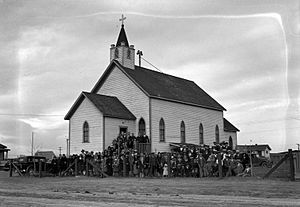Hardieville, Lethbridge facts for kids
Quick facts for kids
Hardieville
|
|
|---|---|
|
Neighbourhood
|
|

Parishioners outside Our Lady of Lourdes Roman Catholic Church in 1930
|
|
| Country | |
| Province | |
| City | Lethbridge |
| Quadrant | NW |
| Established | 1910 |
| Annexed | 1978 |
Hardieville is a residential neighbourhood in the northwest part of Lethbridge, Alberta, Canada. It is located north of Scenic Drive North and west of 13 Street North. It shares borders with other neighbourhoods like Legacy Ridge and Uplands.
Hardieville used to be a small community, or "hamlet," outside Lethbridge. A hamlet is a small settlement, usually smaller than a village. It was named after William Duncan Livingstone Hardie, who was the 13th mayor of Lethbridge. In 1978, Hardieville officially became a part of the City of Lethbridge. This process is called "annexation," meaning the city expanded its boundaries to include the area.
Contents
History of Hardieville
The community of Hardieville grew around the Galt Mine No. 6. This mine was a very important place for coal mining. It operated from 1908 until 1935. The mine site was chosen after a big flood in 1908. This flood affected other mine locations on the west side of the Oldman River.
Many buildings from the Galt Mine No. 6 were later moved. They were taken to the new Galt 8 mine, which is now in West Lethbridge. Today, only a few parts of the old mine site remain. These include parts of the shaft No. 5, a drift tunnel, and buildings like the fan house, engine house, tipple, power house, and boiler house.
Life in the Mining Community
By 1910, about 700 men worked at the Galt Mine. Many of these workers lived right in Hardieville. The community had different types of buildings. There were company houses and residential homes for families. The mine manager also had a house.
Other important places included a shared bath house for workers. There were also water towers, a school for children, a café, and a meat market. Two general stores provided supplies for everyone.
A Diverse Population
The people who lived in Hardieville came from many different places. Early residents were often from Eastern Europe, England, Scotland, and Italy. Later, more immigrants moved into the neighbourhood. These new residents came from Eastern Canada, the United States, Japan, and China. This mix of cultures made Hardieville a diverse and interesting place to live.
Becoming Part of Lethbridge
The Hamlet of Hardieville continued to grow and change over the years. In 1978, it was officially annexed by the City of Lethbridge. This meant Hardieville became a full neighbourhood within the city.

